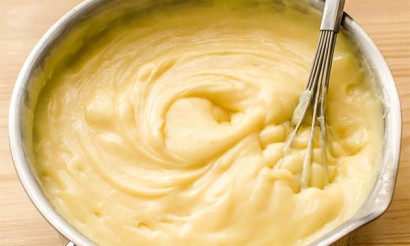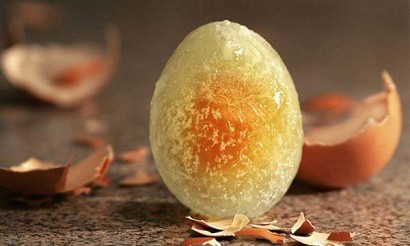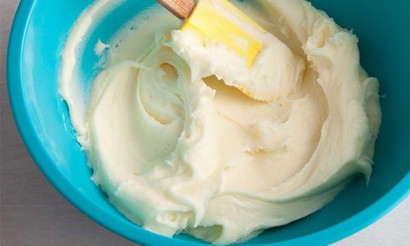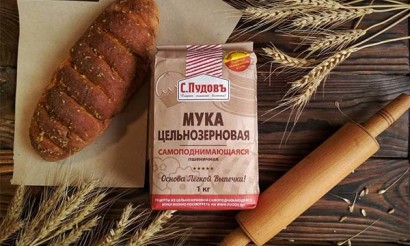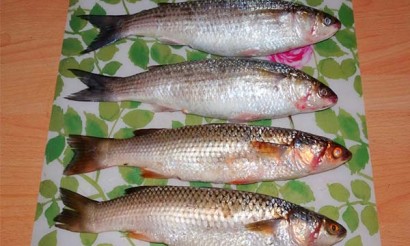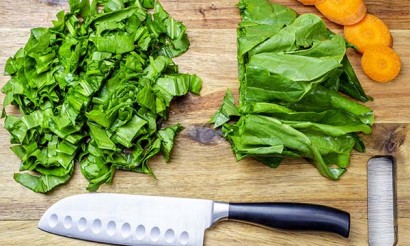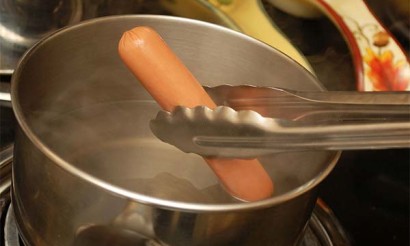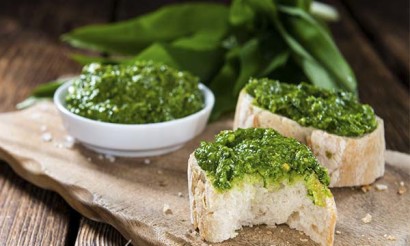How to peel celery and whether it's necessary to do it
Until recently, celery was a fairly rare product, it was not so easy to find on store shelves. Today, in almost every supermarket this product can be purchased all year round. Therefore, the question arises as to whether it should be cleaned. And, if so, how to do it.
There are different opinions on this matter. Some insist that the vegetable does not need to be peeled, it should be eaten with the skin to preserve the useful substances contained in it. Others insist that this process is necessary. After all, the skin is coarse fibers, which have almost no taste, just spoil the texture of dishes, and it is not very pleasant to eat them.
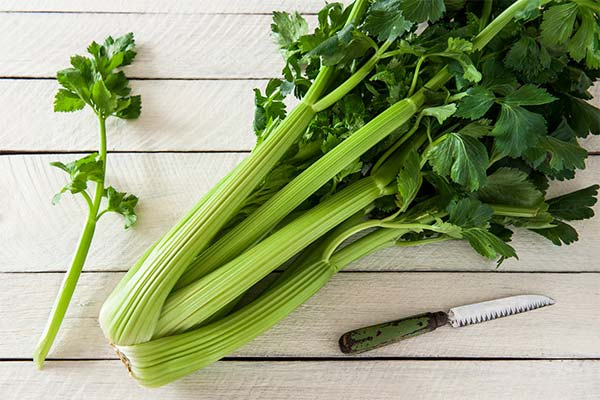
Still, there are tips on what kind of celery and under what circumstances it is necessary to peel, and when you can do without this procedure. Usually the leafy kind is not cleaned, the texture of the leaves allows it to be used without pre-treatment, except for washing in running water. The petiole may also not be peeled if it is young and fresh. Its skin is thin and juicy, so it is good for eating. But if it has been in storage or in the store for a long time and has wilted a bit, then peeling is necessary. In this case, the fibers of the stem become too tough and dehydrated. Root cleaning is mandatory. In addition, it is necessary to carefully remove all darkening, roughness and damage.
What is celery
It is a biennial herbaceous plant that has a spicy aroma and flavor. Its homeland is considered to be the Mediterranean. It is in the cuisine of this region it was widely used in the preparation of a variety of dishes. Both leaves and stems with the root are used as food. Today there are many varieties. There are three types of this plant, depending on which part of it is used in cooking. These are leafy, petiole and root.
Types of celery
Leaf
It was appreciated even by the ancient Greeks. The greens were consumed as food, used in medicine and rituals to honor the gods. It is one of the popular types of celery. In cooking, it is used as a condiment that gives dishes a spicy flavor and as the main ingredient in salads and casseroles. Leafy varieties do not form thick and succulent cuttings and roots. This species is the easiest to cultivate, not afraid of frosts, so it is allowed to grow in the open ground. In the first year the plant gives an abundance of greens, which can be consumed fresh and dried for the winter. When cooking hot dishes, the leaves are chopped and added a couple of minutes before cooking or sprinkled on top at the end of cooking.
Petiole
This species is different in that it forms thick, juicy stems, which have a lot of juice. Its fibers are very soft and suitable for eating. Petiole celery is an important product of many diets, aimed both at losing weight and improving the body. It is consumed fresh, without heat treatment, made into salads, snacks, soups and fried. Juice is squeezed from petiole celery. Very fresh, tasty and healthy cocktails are made by combining it with freshly squeezed juices of other fruits and vegetables.
There are special rules in the cultivation of stem celery, which allows you to get a white and juicy fruit. It is planted in trenches or holes, like potatoes, and dipped throughout the growing season. It is harvested in October.
Root .
This is a round-shaped root vegetable with snow-white flesh. It has a dense structure, sweet-bitter flavor and strong aroma. It is used as a seasoning and as the main ingredient for salads and snacks. It is fried, stewed, cooked aromatic spicy puree as a side dish. You should buy fresh root, it is easier to clean, it has a more pronounced taste and aroma. It also contains more useful substances than the one that is stored for a long time.
Useful properties of celery
The healing effect of this plant on the body has been known since antiquity. It is still recommended for the prevention and treatment of many diseases. This is due to its unique composition. It includes many vitamins (C, PP and B), trace elements (potassium, calcium, phosphorus, sodium), essential oils, amino acids, acetic and oxalic acids. The plant has a bactericidal property, which does not lose its effect even after entering the digestive system. Therefore, it is recommended for disinfecting not only the oral cavity, but also the stomach, intestines and even the urinary system.
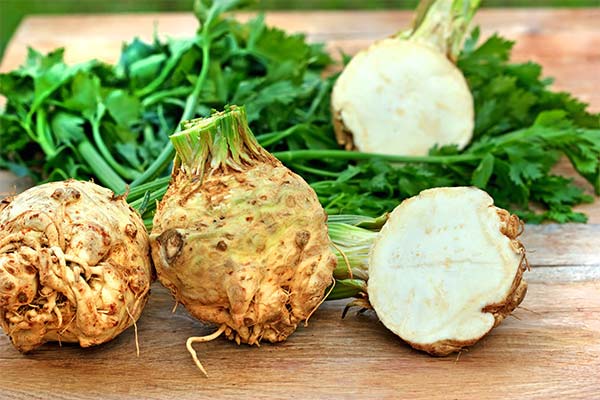
Celery is especially useful for the elderly. It helps to fight rheumatism, strengthens joints and bones, improves metabolism, tones, improves immunity, has a beneficial effect on the central nervous system.
Sodium contained in the composition helps to reduce the consumption of table salt, which has a positive effect on the cardiovascular system. The plant helps to fight with excess weight, as it removes excess fluid from the body and speeds up metabolic processes. Also its use helps to regulate the production of hormones.
All kinds are equally useful. Therefore, you can use the one that you like or is an ingredient of your favorite dish. In any case, the body will get all the trace elements, vitamins and amino acids.
Of course, this plant is most useful in raw form, but even after heat treatment, it retains some of its useful properties.
How to choose celery
When buying the leaves, stems, or root of a plant, you need to know what to look for. As with all greens, the leaves and stems should be bright green. There should be no yellowing or signs of wilting. This indicates that it has been stored for a long time or that too much fertilizer has been used in its cultivation. The leaves should not have too much gloss. They are usually slightly matte. A perfectly smooth surface is obtained if the plant has been treated with special compositions to increase the shelf life.
The stalks of a quality and fresh product are strong, fleshy and juicy. When you separate the petiole there is a sharp crunch. When buying the petiole species, you should refrain from choosing those specimens that have a seed arrow in the center. Such a plant can be very bitter.
When choosing a root vegetable, pay attention to smooth and even specimens without damage, darkness and soft spots on the surface. Of the two options of the same size, it is recommended to choose the heavier one. It will be denser and juicier. Also, the smooth skin will facilitate the peeling process.
Only fresh products will contain the necessary amount of useful substances. Those that have had time to wilt a little, already lose their flavor and aroma.
How to peel celery correctly
Each species requires its own way of preliminary preparation and cleaning.
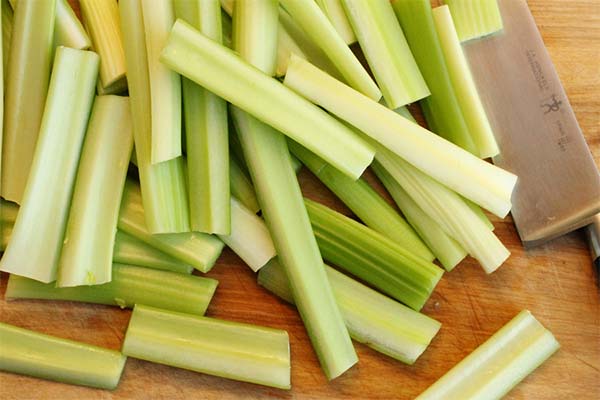
Petioles
If the stalks are very young, the skin is still thin and delicate, so you can not remove it. It is enough to rinse well, dry and use for cooking. In the case where the product is already well matured, stored for a long time, you should get rid of the skin. It does not affect the taste of dishes, but its tough fibers will interfere with the meal, cause discomfort.
- The first thing to do is to cut off the lower part, to which the stems are attached, also remove the leaves and the dried out upper tips. Only after removing the rosette, wash the cuttings thoroughly in running water. If washed without removing the base, dirt and sand may linger there.
- Then remove the tough fibers. They pull like threads. This can be done by hand, cut with a regular knife. But more effective will be the use of a vegetable peeler.
- After cleaning, check the quality of the work. To do this, break the stem. If threads remain, they should be removed.
Now the stalks can be sliced and prepare salads, snacks, smoothies.
Leaf
This type of plant is not peeled. Mostly the leaves are used, so it is enough to tear them off the tough stems, rinse them in water, dry them, if necessary, chop them.
The stems can also be used, for example, in a broth, they will give their flavor, then they should be taken out and thrown away. They are not suitable for eating, as they are very tough and fibrous.
Root
The root vegetable requires more careful preparation before cooking and eating. It is always covered with a very tough skin. There are also often knots and irregularities on the surface. Since its flesh is very dense, you will have to make considerable effort to peel it.
- First, wash the root thoroughly to get rid of lumps of soil. You can use a coarse sponge or a dish brush for this purpose.
- Then use a knife to cut off the lower and upper parts of the fruit.
- If you do not plan to cook the whole root vegetable immediately, you should not peel it whole. You need to cut off the amount that will be used in the dish. Put the rest of it in the refrigerator for storage, without wrapping it in foil and not putting it in a bag.
- From the prepared piece with a knife cut off all the skin, remove knots, cracks and darkening. The flesh should be absolutely clean and white.
- In the flesh can be distinguished spongy part, it is denser. If the root vegetable is just used for cooking and not cleaning the body, it is better to cut it out and throw it away. It has no flavor, but it takes a long time to digest. It is used by those going through the detoxification process.
- Once again, rinse the peeled piece and slice it for a dish. If the product will not be used immediately, it must be covered with water, otherwise the pieces will quickly darken.
How to eat celery properly
In the consumption of such a useful product has its own peculiarities. Despite all its useful properties, celery can cause harm under certain circumstances. It is not recommended for pregnant and lactating women, those who have a high acidity of the stomach, there are stones in the kidneys, sufferers of epilepsy. The rest of them can safely eat it, strengthening their health.

Each species has its own application. So, the stems prefer to eat fresh. They are very juicy and tender, suitable for salads and snacks. For example, you can dip the stalks sliced into hummus or other sauces.
Leaves can be used fresh or added to dishes during cooking. So that they do not lose their useful properties from heat treatment, it is recommended to add them 1-2 minutes before cooking.
The root can also be eaten raw by preparing a salad, or stewed with vegetables and meat. Today, a flavorful mashed potatoes from the root for a side dish has become very popular. Its spicy flavor shades and emphasizes the taste of meat well.
Terms and conditions of storage
It is necessary to remember that celery does not store for a long time. It should be bought fresh and try to use immediately. But if there is a need to extend its shelf life, you can use the following tips.
Extend the shelf life for 1-2 weeks will help the refrigerator. The product should first be well washed, then put it on a napkin or cloth, let it dry. Afterwards, place the plant in airtight packaging. You can use foil, plastic food film, bags or containers. The product is stored in a container in the lower compartment or on the central shelf of the refrigerator.
If you want to make preparations for the winter, then you can freeze it. First, the product should be well washed, peeled, dried on a towel. Then the leaves are pounded in a blender or other way. Shredded mass spread in molds for freezing ice, pour clean water and put in the freezer. For convenience, you can later take cubes out of the form and put into a bag. When you need to add to the dish, just take out a cube and throw it in the broth or sauce. You can also freeze whole leaves. They must be removed from the stem, evenly distributed in a bag and frozen. This way you can preserve the product for 6-12 months. In addition, freezing does not destroy the useful substances and vitamins. The root can also be frozen, but it should be chopped beforehand.
Drying is another way to preserve the product until the next harvest. The leaves and the root are dried. The root should be chopped into manageable pieces. Leaves can be dried whole or chopped.
But to store just like that on a shelf in a cabinet or on a table will be the most unfortunate solution. The product will begin to spoil after 3 days. In such a case, there is a way to extend this period. To do this, it is necessary to put the celery in a tank of water. The liquid should hide the product by half. In this way, it will keep for 5 days, but the water must be changed daily.
What can be cooked with celery
Leaves are used as a condiment to dishes, used fresh or cooked. But the stems and root can be individual ingredients, from which a huge number of delicious, flavorful and healthy dishes can be prepared.
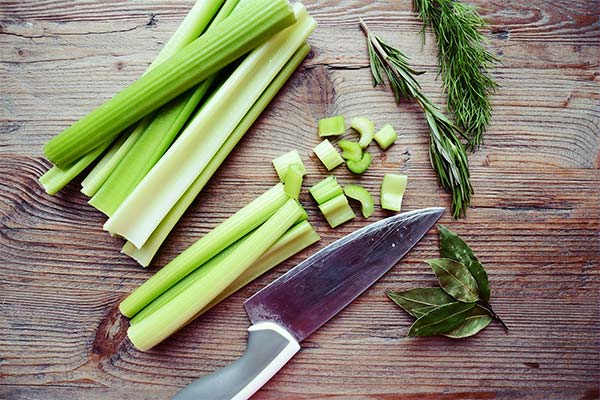
It is better to get the nutrients in the morning. A simple celery stalk smoothie will help.
Smoothie
Ingredients:
- 3 medium celery stalks;
- 1 apple;
- 0.5 l of milk;
- salt, sugar as desired.
Preparation:
- Peel the celery, if necessary, chop into pieces.
- Dice the apple.
- Put all the ready products into the blender flask. Pour the milk. Grind to a smooth paste.
Serve in tall glasses. You can decorate with strips of celery stalks.
Celery salad with raisins
Also a treasure trove of vitamins and nutrients is a fresh salad with all kinds of celery.
Ingredients:
- 200 g of all kinds of celery (root, petioles, herbs);
- 50 g of white raisins raisins;
- 1-2 sprigs of parsley;
- 30 ml apple cider vinegar;
- 50 ml vegetable oil, preferably olive oil;
- salt, pepper as desired.
Preparation:
- Wash all the products, dry and clean the ones that need it.
- Prepare the sauce for the dressing. Mix vinegar, oil, salt and pepper in a bowl. Whisk thoroughly. Add the raisins. Leave for 30 minutes, let the raisins soak and absorb the flavors.
- Peeled celery root and cut into thin julienne strips.
- Chop the petioles into slices, chop the parsley and celery leaves.
- Put the ingredients into a deep salad bowl, pour the sauce and mix. Let stand for another 30 minutes.
Vegetable soup puree
You can make a delicate celery stalk soup for lunch.
Ingredients:
- 1 bunch of stalked celery;
- 4 medium potatoes;
- 1 onion;
- 1 carrot;
- 1 medium tomato;
- vegetable oil;
- seasoning to taste.
Preparation:
- Peel and prepare ingredients. Dice potatoes, celery slices. All put into a pot, add water, salt and put on medium heat to boil.
- Shred the onion. Peel and grate carrots. Heat the oil in a frying pan and fry the onion and carrot.
- Remove the skin from the tomato, finely chop and add to the carrots and onions when they are almost ready. Stew for 10 minutes.
- Add the steamed vegetables to the pot and simmer together a little longer.
- When the potatoes and celery are ready, remove from the stove. Process with a blender until smooth. Bring back to the boil.
- When the soup comes to the boil, remove it from the heat. Pour onto plates and serve.
Dessert Salad
You can make an original and delicious dessert from this flavorful product.
Ingredients:
- 1 bunch of stalked celery;
- 200 g strawberries;
- 25 g of ginger root;
- 70 g sugar;
- 125 ml water.
Preparation:
- Boil the ginger syrup in advance. To do this, peel the root, chop it into thin petals. Pour water into a saucepan, add the sugar and ginger. Heat it, stirring and boil for 15 minutes.
- Peel celery stalks, cut into thin slices. Place some in the bottom of the crème brûls or glasses.
- Cut the strawberries into small slices. Place on top of the celery. Then repeat again, alternating layers.
Leave the syrup to cool and pour over the dessert. Leave to stand for 10-15 minutes. Serve with a scoop of vanilla ice cream.
«Important: All information on this site is provided for informational purposes only for information purposes only. Consult with a health care professional before using any of the recommendations. health care professional before using any of the information. Neither the editors nor the authors shall be liable for any possible harm caused by materials."

